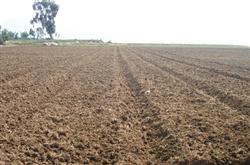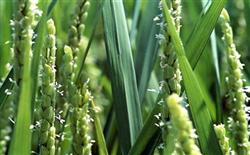Characteristics and control strategies of rice planthopper

Baohe Township, located in the southwest of Jinghe County, is a hilly area. The township has 9144 mu of arable land and 7813 mu of paddy field, which is a typical agricultural township in mountainous areas. Rice planthopper (Nilaparvata lugens) is a common pest that seriously damages rice in our village, causing losses to varying degrees every year. Especially in the past two years, the rice yield has been seriously damaged due to the influence of climate and other factors, which has been strongly reflected by the broad masses of farmers. Our station organized technical forces, on-the-spot observation and understanding, took rice planthopper as the main target of rice pest control, adopted a series of control countermeasures, and achieved good social and economic benefits. 1. Harmful symptoms. At the initial stage of damage, there were many irregular brown spots on the stem, and when the damage was serious, the whole plant withered and gradually expanded into pieces; rice was damaged at booting stage, could not heading, and was killed after heading, which affected rice plumpness, reduced 1000-grain weight and high grained grain rate. 2. The period of occurrence. Rice planthopper can occur from early rice seedling field to early October. There were two nymph peaks in early rice, the first from late May to early June, the second from late June to early July, the first nymph peak from mid-late June to early July, the second from mid-late July to early August, the first nymph peak in late rice from mid-late August to late September, and the second from mid-late September to early October. Generally, after transplanting double late rice, it is from late July to early August, and the number of rice planthopper is abnormal, which needs to be controlled in a large area. The white-backed planthopper accounted for more than 70% of the total in the peak period of the main damage generation, and white-backed planthopper was dominant in the early stage of late rice, and then the proportion of brown planthopper increased, up to 70% of the total planthopper. 3. The number of migratory worms in ⑴ increased. The adults were not seen until June 9 under the early rice lamp, 10 days earlier than the previous year. As of July 13, a total of 6782 insects were trapped by a single lamp, an increase of 70.1% compared with the average of the same period in the past three years, of which five obvious peaks appeared under the lights on June 23, June 26, June 29, July 5 and July 8. 225,560,856,950 and 2100 respectively. The number of insects in the field was investigated on June 21th, June 26th, July 26th, July 26th, July 26th, Most of them are young nymphs, but there are more long-winged adults (136 per 100 clumps, 3.4 times that of the same period in 2002). A small number of short-winged adults were found in the field. The nymph peak in 2002, 2001 and 2000 were 4934, 1174 and 4574 per hundred clumps, respectively. According to the field egg number survey on July 13, 8060 grains per 100 clumps of single cropping rice, an increase of 39.8% compared with the average in the past three years. ⑵ climate factors. The average temperature in the middle and late August of 2002 and 2003 was 2-3 ℃ lower than the usual year, and the temperature in the middle and late September was higher than that in previous years, while the rice was in the peak tillering stage to booting stage, and the rich food conditions and hot and humid climate were very favorable for the occurrence of the pest. ⑶ prevention and control factors. Farmers can control rice stem borer and other pests and inhibit the growth of rice planthopper to a certain extent; on the other hand, because farmers are relatively independent and dispersed, differences in the type and frequency of drug use also affect rice planthopper. 4. Prevention and control countermeasures. ⑴ selected insect-resistant and high-yielding varieties. The selection of hybrid rice combinations such as Weiyou 191, Ⅱ you 6078 and Guofeng 1 can get twice the result with half the effort in controlling the damage of rice planthopper. ⑵ fertilized rationally. Pay attention to the rational application of nitrogen, phosphorus and potassium, re-apply base fertilizer, apply fertilizer early, control the overgrowth of seedlings, improve the insect resistance of rice, and create a rice field environment that is not conducive to the occurrence of rice planthopper. ⑶ eliminated the source of overwintering insects. The insect eggs overwintered in the stems of Gramineae weeds beside the fields, ditches and ponds, and accumulated fertilizer in winter to eradicate the weeds beside the fields and ponds to eliminate the overwintering insect source. ⑷ uses natural predators. Reduce the use of pesticides in the early stage of rice field, and try not to use chemical pesticides that are lethal to natural enemies. ⑸ is used scientifically. The amount of water should be sufficient to ensure that the lower part of the rice plant is drenched with the liquid, and the shallow water layer in the field is about 6 cm, so as to improve the control effect. Low-toxic and low-residue pesticides such as propofol or Zhuang'ai are generally used. 5. The results achieved. ⑴ controls the damage of planthopper, and the protection benefit is remarkable. In 2003, our township recovered 389 tons of rice through prevention and control. ⑵ reduces the frequency of drug use, improves the ecological environment, and has remarkable social benefits.
- Prev

Occurrence characteristics and control techniques of rice false smut
1. Occurrence characteristics of rice false smut disease only occurs in panicle, generally from flowering to milk ripening of rice. The infected grain grows in glume and forms rice false smut with a diameter of about 1 cm instead of rice grain. The optimum temperature for germination and development of Ustilaginoidea virens was 25~30℃, 34℃ or 12 ℃.
- Next

Rice heading difficulty can be sprayed with gibberellin
It is difficult for rice to heading, or the phenomenon of neck wrapping appears. Because the rice grains wrapped in the leaf sheath can not be pollinated and fertilized in time, they will generally become empty grains, which has a great impact on the yield. There are many reasons for this phenomenon, some of which are more serious in terms of neck wrapping, especially in adverse environmental conditions.
Related
- The first cup of black tea in spring, the flavor and history of tea gardens in Kenya, Africa
- The computer can not only choose potatoes, but also grow tea rice. AI will grow winter oolong tea champion.
- It is not only the inflated tea bitten by insects, but also engraved with the four seasons tea in Beipu.
- The Oriental Beauty Tea Festival in Zhuxian County takes the stage at the weekend to experience the plus-size feast of oil tea.
- & quot; Oriental Beauty Tea & Exploration of Emei in Hsinchu, the hometown of quot;
- The new variety of strawberry "Tainong 1" dessert is the first choice with mellow aroma. Crimson gorgeous
- History of Tea in Taiwan: from Wild Inner Mountain to Export Tea Garden
- Two types of Taiwan Oriental Beauty Black Tea won the British three-Star Award for Childhood Tea Xiang Zhang Jiaqi changed from pilot to champion tea maker.
- Banana species and varieties: the planting history of Taiwan Xianren banana and dwarf banana is long, is banana disease resistant?
- Coffee planting Technology: Qianjie Coffee from Seedling to harvesting

